Introduction to Marketing: Techniques, Research, and Mix Report
VerifiedAdded on 2020/06/05
|11
|2948
|235
Report
AI Summary
This report provides an in-depth analysis of marketing principles and practices. It begins by defining marketing and its core functions, then explores how marketing techniques are applied in two organizations: Apple and the British Red Cross. The report delves into the limitations and constraints of marketing, particularly concerning consumer law and regulations. It examines the role of marketing research, including primary and secondary research methods, and illustrates the use of SWOT analysis for marketing planning. The report also covers market segmentation, explaining how businesses target specific customer groups. Finally, it discusses the marketing mix for a new product or service, providing a comprehensive overview of key marketing concepts and their practical application. The report includes references to support the information provided.
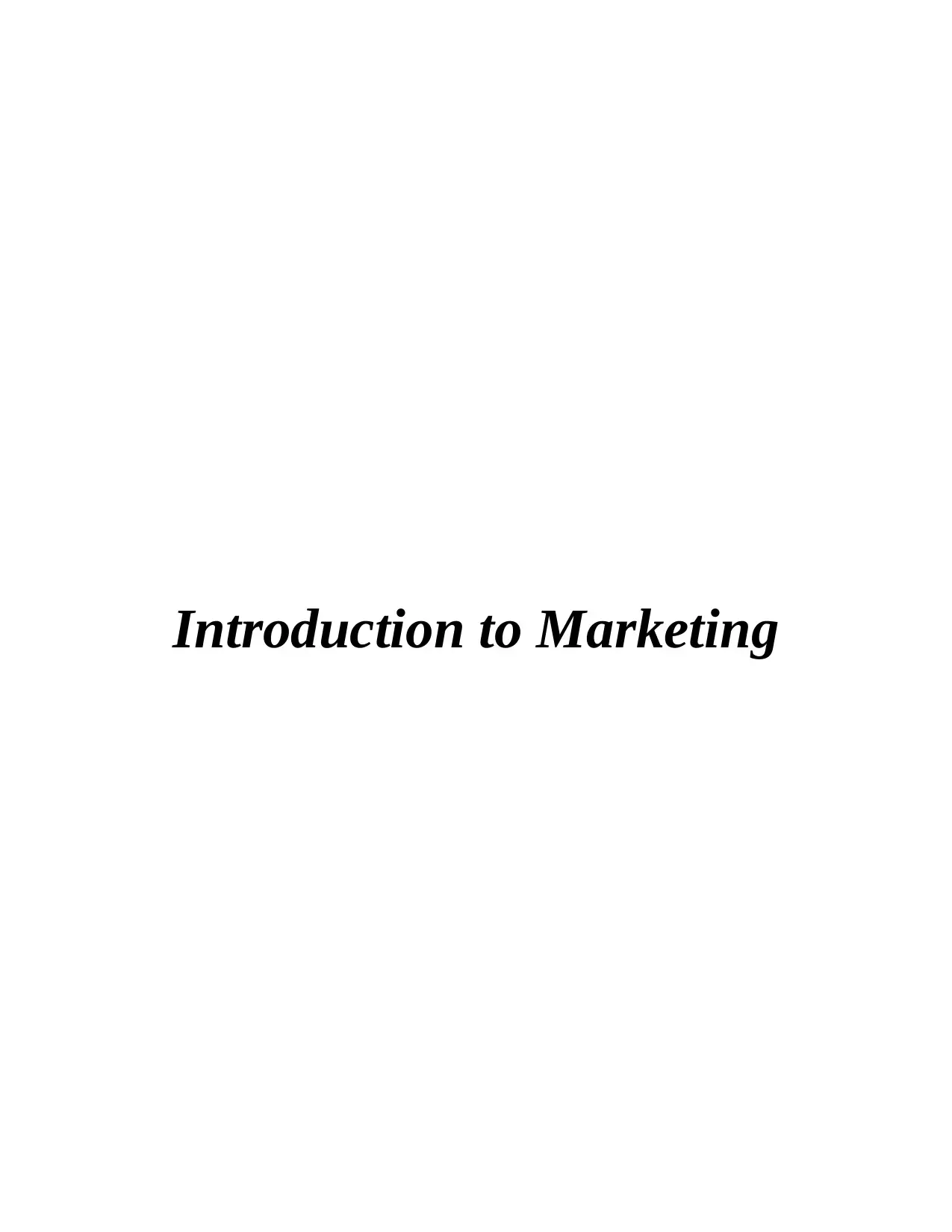
Introduction to Marketing
Paraphrase This Document
Need a fresh take? Get an instant paraphrase of this document with our AI Paraphraser
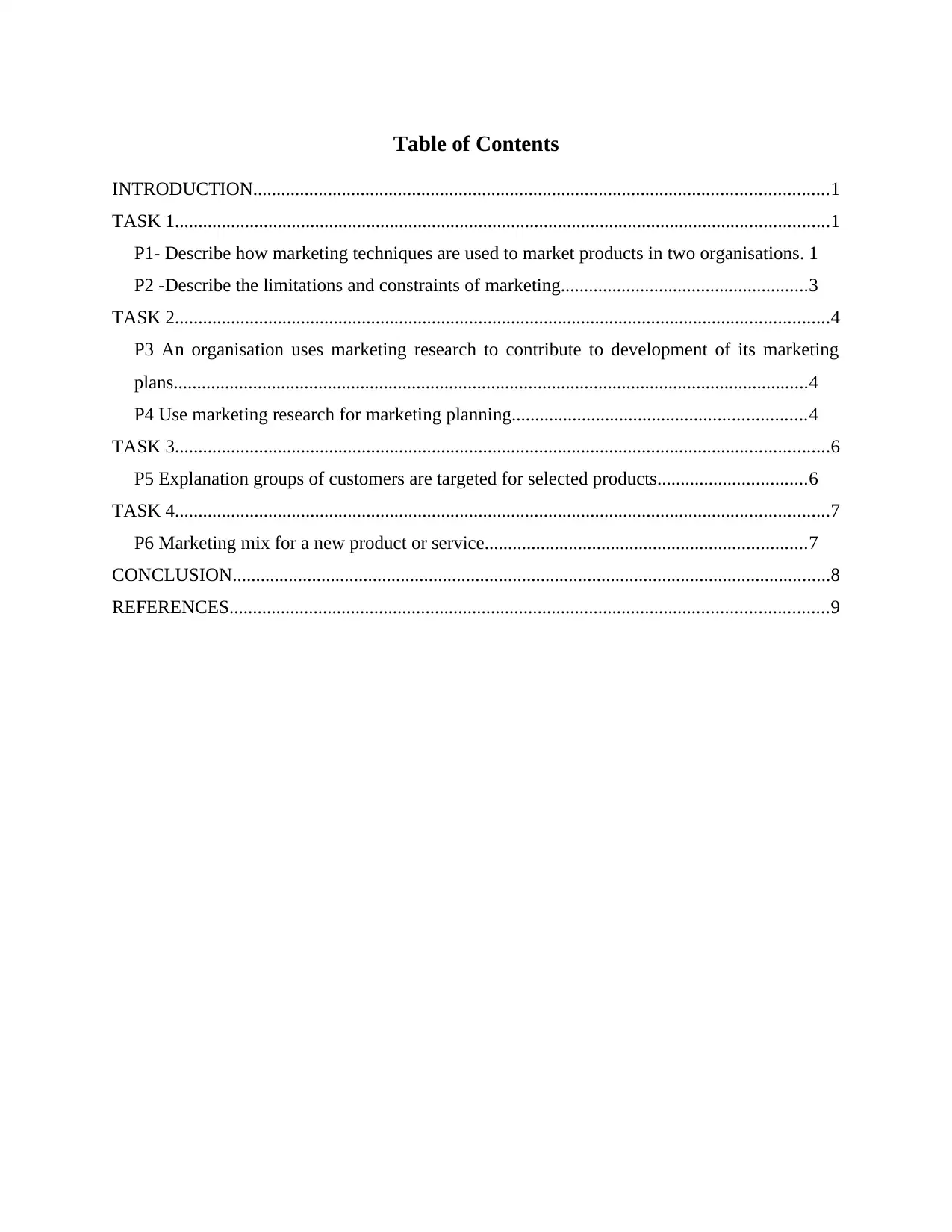
Table of Contents
INTRODUCTION...........................................................................................................................1
TASK 1............................................................................................................................................1
P1- Describe how marketing techniques are used to market products in two organisations. 1
P2 -Describe the limitations and constraints of marketing.....................................................3
TASK 2............................................................................................................................................4
P3 An organisation uses marketing research to contribute to development of its marketing
plans........................................................................................................................................4
P4 Use marketing research for marketing planning...............................................................4
TASK 3............................................................................................................................................6
P5 Explanation groups of customers are targeted for selected products................................6
TASK 4............................................................................................................................................7
P6 Marketing mix for a new product or service.....................................................................7
CONCLUSION................................................................................................................................8
REFERENCES................................................................................................................................9
INTRODUCTION...........................................................................................................................1
TASK 1............................................................................................................................................1
P1- Describe how marketing techniques are used to market products in two organisations. 1
P2 -Describe the limitations and constraints of marketing.....................................................3
TASK 2............................................................................................................................................4
P3 An organisation uses marketing research to contribute to development of its marketing
plans........................................................................................................................................4
P4 Use marketing research for marketing planning...............................................................4
TASK 3............................................................................................................................................6
P5 Explanation groups of customers are targeted for selected products................................6
TASK 4............................................................................................................................................7
P6 Marketing mix for a new product or service.....................................................................7
CONCLUSION................................................................................................................................8
REFERENCES................................................................................................................................9
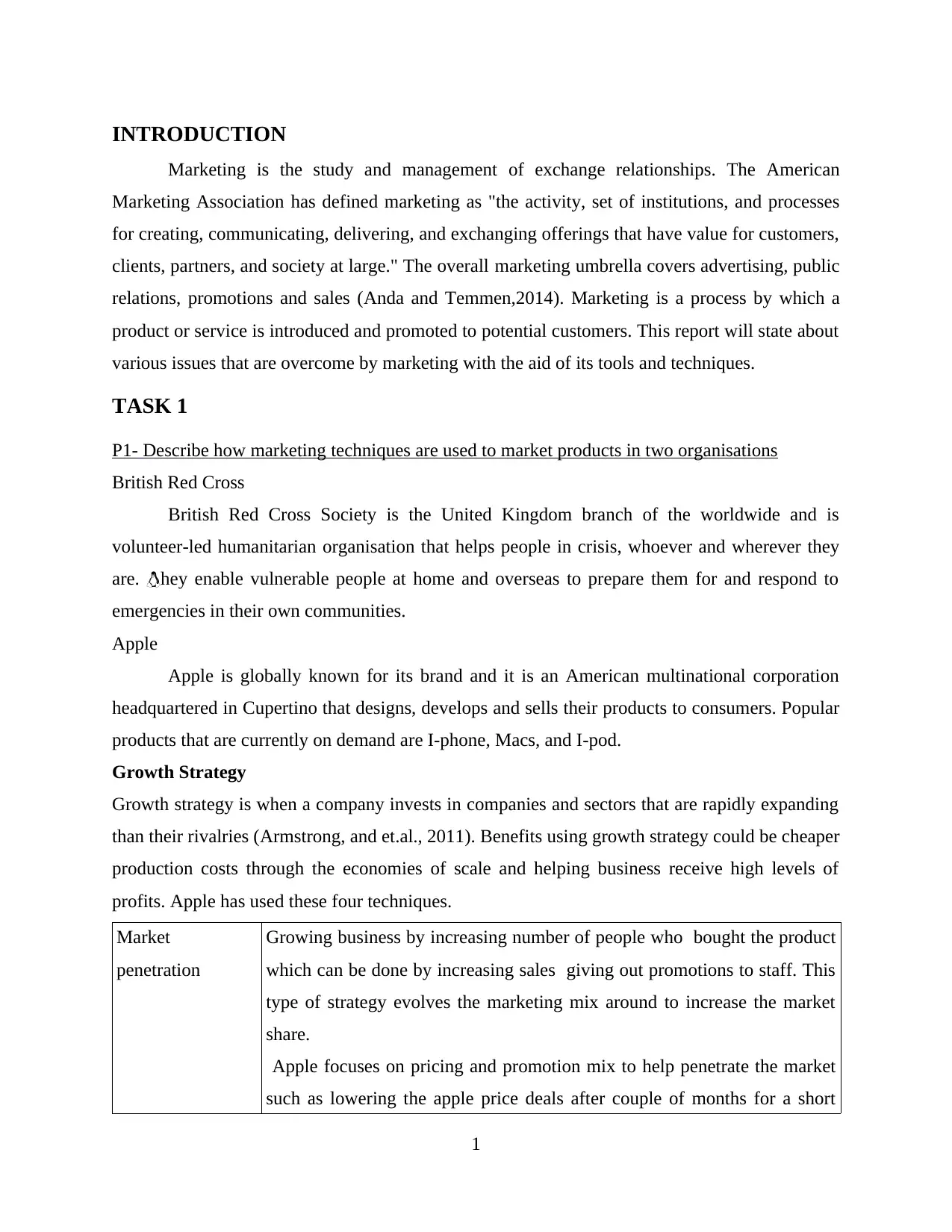
INTRODUCTION
Marketing is the study and management of exchange relationships. The American
Marketing Association has defined marketing as "the activity, set of institutions, and processes
for creating, communicating, delivering, and exchanging offerings that have value for customers,
clients, partners, and society at large." The overall marketing umbrella covers advertising, public
relations, promotions and sales (Anda and Temmen,2014). Marketing is a process by which a
product or service is introduced and promoted to potential customers. This report will state about
various issues that are overcome by marketing with the aid of its tools and techniques.
TASK 1
P1- Describe how marketing techniques are used to market products in two organisations
British Red Cross
British Red Cross Society is the United Kingdom branch of the worldwide and is
volunteer-led humanitarian organisation that helps people in crisis, whoever and wherever they
are. hey enable vulnerable people at home and overseas to prepare them for and respond to
emergencies in their own communities.
Apple
Apple is globally known for its brand and it is an American multinational corporation
headquartered in Cupertino that designs, develops and sells their products to consumers. Popular
products that are currently on demand are I-phone, Macs, and I-pod.
Growth Strategy
Growth strategy is when a company invests in companies and sectors that are rapidly expanding
than their rivalries (Armstrong, and et.al., 2011). Benefits using growth strategy could be cheaper
production costs through the economies of scale and helping business receive high levels of
profits. Apple has used these four techniques.
Market
penetration
Growing business by increasing number of people who bought the product
which can be done by increasing sales giving out promotions to staff. This
type of strategy evolves the marketing mix around to increase the market
share.
Apple focuses on pricing and promotion mix to help penetrate the market
such as lowering the apple price deals after couple of months for a short
1
Marketing is the study and management of exchange relationships. The American
Marketing Association has defined marketing as "the activity, set of institutions, and processes
for creating, communicating, delivering, and exchanging offerings that have value for customers,
clients, partners, and society at large." The overall marketing umbrella covers advertising, public
relations, promotions and sales (Anda and Temmen,2014). Marketing is a process by which a
product or service is introduced and promoted to potential customers. This report will state about
various issues that are overcome by marketing with the aid of its tools and techniques.
TASK 1
P1- Describe how marketing techniques are used to market products in two organisations
British Red Cross
British Red Cross Society is the United Kingdom branch of the worldwide and is
volunteer-led humanitarian organisation that helps people in crisis, whoever and wherever they
are. hey enable vulnerable people at home and overseas to prepare them for and respond to
emergencies in their own communities.
Apple
Apple is globally known for its brand and it is an American multinational corporation
headquartered in Cupertino that designs, develops and sells their products to consumers. Popular
products that are currently on demand are I-phone, Macs, and I-pod.
Growth Strategy
Growth strategy is when a company invests in companies and sectors that are rapidly expanding
than their rivalries (Armstrong, and et.al., 2011). Benefits using growth strategy could be cheaper
production costs through the economies of scale and helping business receive high levels of
profits. Apple has used these four techniques.
Market
penetration
Growing business by increasing number of people who bought the product
which can be done by increasing sales giving out promotions to staff. This
type of strategy evolves the marketing mix around to increase the market
share.
Apple focuses on pricing and promotion mix to help penetrate the market
such as lowering the apple price deals after couple of months for a short
1
⊘ This is a preview!⊘
Do you want full access?
Subscribe today to unlock all pages.

Trusted by 1+ million students worldwide
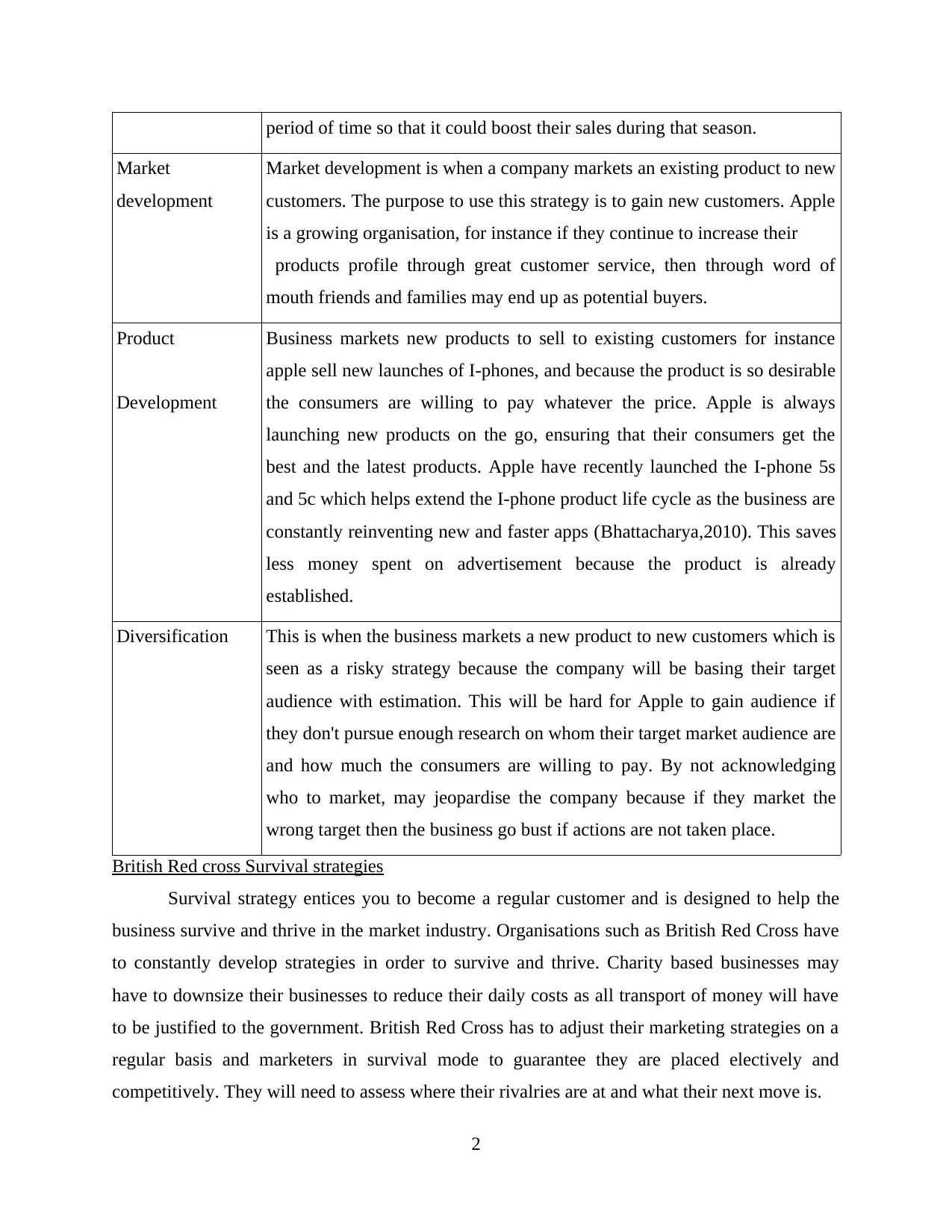
period of time so that it could boost their sales during that season.
Market
development
Market development is when a company markets an existing product to new
customers. The purpose to use this strategy is to gain new customers. Apple
is a growing organisation, for instance if they continue to increase their
products profile through great customer service, then through word of
mouth friends and families may end up as potential buyers.
Product
Development
Business markets new products to sell to existing customers for instance
apple sell new launches of I-phones, and because the product is so desirable
the consumers are willing to pay whatever the price. Apple is always
launching new products on the go, ensuring that their consumers get the
best and the latest products. Apple have recently launched the I-phone 5s
and 5c which helps extend the I-phone product life cycle as the business are
constantly reinventing new and faster apps (Bhattacharya,2010). This saves
less money spent on advertisement because the product is already
established.
Diversification This is when the business markets a new product to new customers which is
seen as a risky strategy because the company will be basing their target
audience with estimation. This will be hard for Apple to gain audience if
they don't pursue enough research on whom their target market audience are
and how much the consumers are willing to pay. By not acknowledging
who to market, may jeopardise the company because if they market the
wrong target then the business go bust if actions are not taken place.
British Red cross Survival strategies
Survival strategy entices you to become a regular customer and is designed to help the
business survive and thrive in the market industry. Organisations such as British Red Cross have
to constantly develop strategies in order to survive and thrive. Charity based businesses may
have to downsize their businesses to reduce their daily costs as all transport of money will have
to be justified to the government. British Red Cross has to adjust their marketing strategies on a
regular basis and marketers in survival mode to guarantee they are placed electively and
competitively. They will need to assess where their rivalries are at and what their next move is.
2
Market
development
Market development is when a company markets an existing product to new
customers. The purpose to use this strategy is to gain new customers. Apple
is a growing organisation, for instance if they continue to increase their
products profile through great customer service, then through word of
mouth friends and families may end up as potential buyers.
Product
Development
Business markets new products to sell to existing customers for instance
apple sell new launches of I-phones, and because the product is so desirable
the consumers are willing to pay whatever the price. Apple is always
launching new products on the go, ensuring that their consumers get the
best and the latest products. Apple have recently launched the I-phone 5s
and 5c which helps extend the I-phone product life cycle as the business are
constantly reinventing new and faster apps (Bhattacharya,2010). This saves
less money spent on advertisement because the product is already
established.
Diversification This is when the business markets a new product to new customers which is
seen as a risky strategy because the company will be basing their target
audience with estimation. This will be hard for Apple to gain audience if
they don't pursue enough research on whom their target market audience are
and how much the consumers are willing to pay. By not acknowledging
who to market, may jeopardise the company because if they market the
wrong target then the business go bust if actions are not taken place.
British Red cross Survival strategies
Survival strategy entices you to become a regular customer and is designed to help the
business survive and thrive in the market industry. Organisations such as British Red Cross have
to constantly develop strategies in order to survive and thrive. Charity based businesses may
have to downsize their businesses to reduce their daily costs as all transport of money will have
to be justified to the government. British Red Cross has to adjust their marketing strategies on a
regular basis and marketers in survival mode to guarantee they are placed electively and
competitively. They will need to assess where their rivalries are at and what their next move is.
2
Paraphrase This Document
Need a fresh take? Get an instant paraphrase of this document with our AI Paraphraser
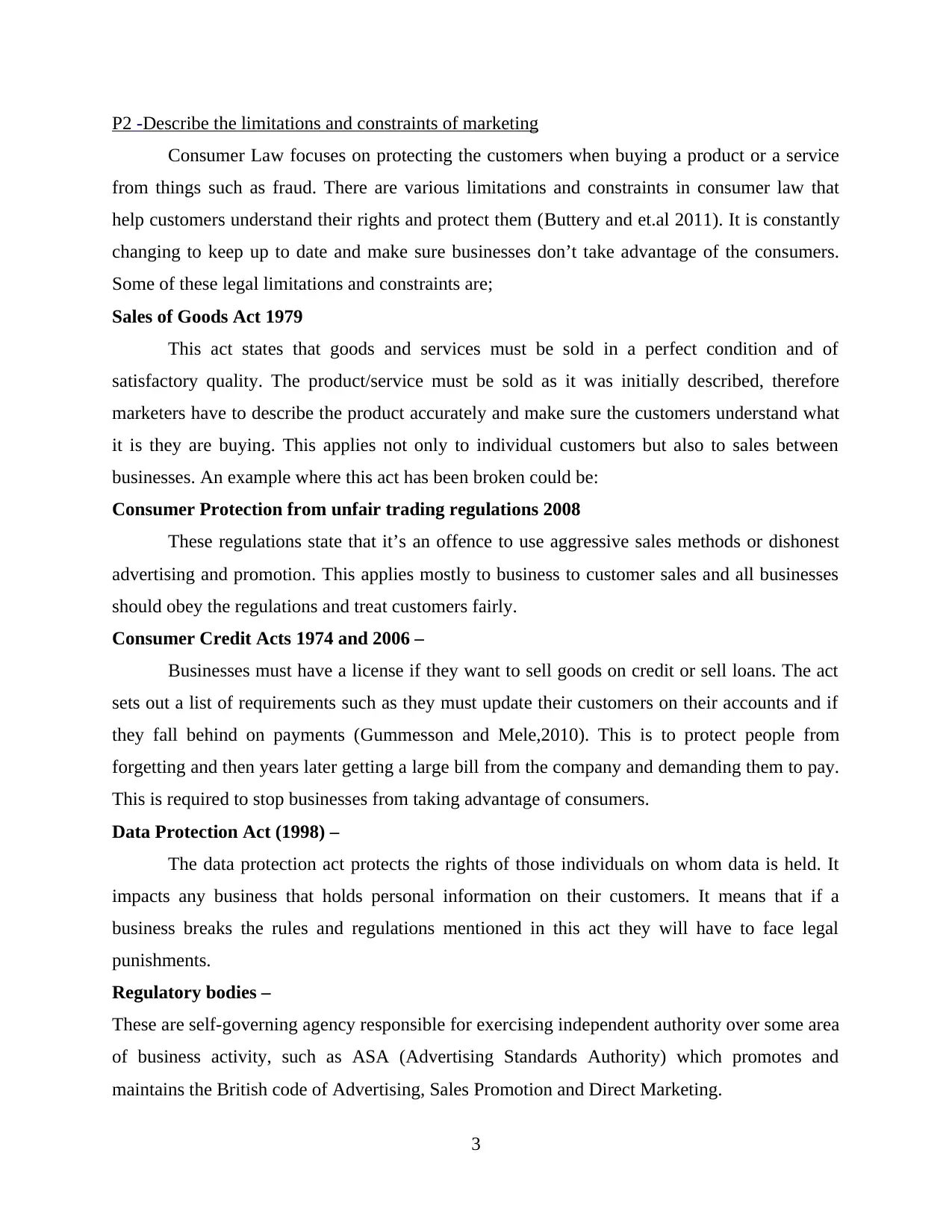
P2 -Describe the limitations and constraints of marketing
Consumer Law focuses on protecting the customers when buying a product or a service
from things such as fraud. There are various limitations and constraints in consumer law that
help customers understand their rights and protect them (Buttery and et.al 2011). It is constantly
changing to keep up to date and make sure businesses don’t take advantage of the consumers.
Some of these legal limitations and constraints are;
Sales of Goods Act 1979
This act states that goods and services must be sold in a perfect condition and of
satisfactory quality. The product/service must be sold as it was initially described, therefore
marketers have to describe the product accurately and make sure the customers understand what
it is they are buying. This applies not only to individual customers but also to sales between
businesses. An example where this act has been broken could be:
Consumer Protection from unfair trading regulations 2008
These regulations state that it’s an offence to use aggressive sales methods or dishonest
advertising and promotion. This applies mostly to business to customer sales and all businesses
should obey the regulations and treat customers fairly.
Consumer Credit Acts 1974 and 2006 –
Businesses must have a license if they want to sell goods on credit or sell loans. The act
sets out a list of requirements such as they must update their customers on their accounts and if
they fall behind on payments (Gummesson and Mele,2010). This is to protect people from
forgetting and then years later getting a large bill from the company and demanding them to pay.
This is required to stop businesses from taking advantage of consumers.
Data Protection Act (1998) –
The data protection act protects the rights of those individuals on whom data is held. It
impacts any business that holds personal information on their customers. It means that if a
business breaks the rules and regulations mentioned in this act they will have to face legal
punishments.
Regulatory bodies –
These are self-governing agency responsible for exercising independent authority over some area
of business activity, such as ASA (Advertising Standards Authority) which promotes and
maintains the British code of Advertising, Sales Promotion and Direct Marketing.
3
Consumer Law focuses on protecting the customers when buying a product or a service
from things such as fraud. There are various limitations and constraints in consumer law that
help customers understand their rights and protect them (Buttery and et.al 2011). It is constantly
changing to keep up to date and make sure businesses don’t take advantage of the consumers.
Some of these legal limitations and constraints are;
Sales of Goods Act 1979
This act states that goods and services must be sold in a perfect condition and of
satisfactory quality. The product/service must be sold as it was initially described, therefore
marketers have to describe the product accurately and make sure the customers understand what
it is they are buying. This applies not only to individual customers but also to sales between
businesses. An example where this act has been broken could be:
Consumer Protection from unfair trading regulations 2008
These regulations state that it’s an offence to use aggressive sales methods or dishonest
advertising and promotion. This applies mostly to business to customer sales and all businesses
should obey the regulations and treat customers fairly.
Consumer Credit Acts 1974 and 2006 –
Businesses must have a license if they want to sell goods on credit or sell loans. The act
sets out a list of requirements such as they must update their customers on their accounts and if
they fall behind on payments (Gummesson and Mele,2010). This is to protect people from
forgetting and then years later getting a large bill from the company and demanding them to pay.
This is required to stop businesses from taking advantage of consumers.
Data Protection Act (1998) –
The data protection act protects the rights of those individuals on whom data is held. It
impacts any business that holds personal information on their customers. It means that if a
business breaks the rules and regulations mentioned in this act they will have to face legal
punishments.
Regulatory bodies –
These are self-governing agency responsible for exercising independent authority over some area
of business activity, such as ASA (Advertising Standards Authority) which promotes and
maintains the British code of Advertising, Sales Promotion and Direct Marketing.
3
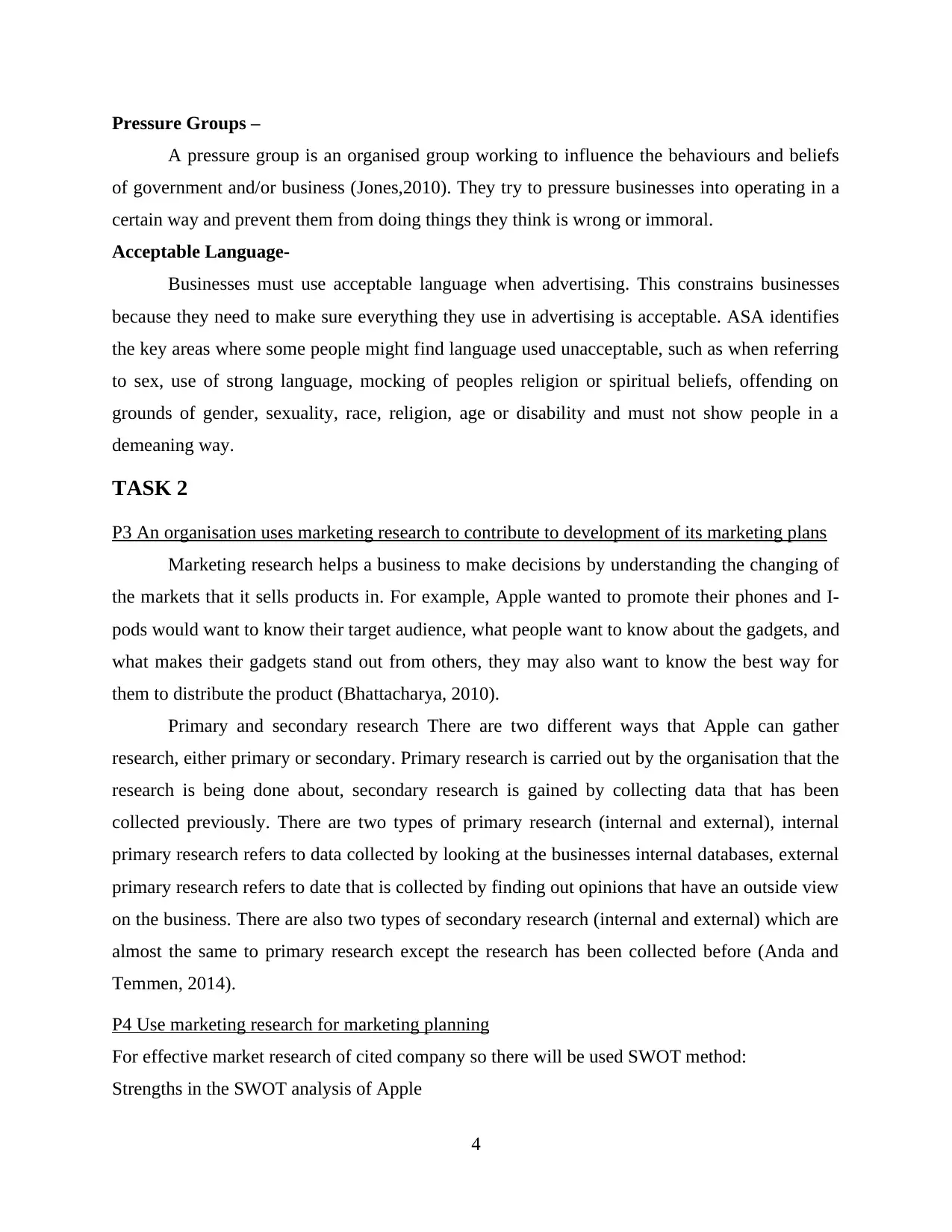
Pressure Groups –
A pressure group is an organised group working to influence the behaviours and beliefs
of government and/or business (Jones,2010). They try to pressure businesses into operating in a
certain way and prevent them from doing things they think is wrong or immoral.
Acceptable Language-
Businesses must use acceptable language when advertising. This constrains businesses
because they need to make sure everything they use in advertising is acceptable. ASA identifies
the key areas where some people might find language used unacceptable, such as when referring
to sex, use of strong language, mocking of peoples religion or spiritual beliefs, offending on
grounds of gender, sexuality, race, religion, age or disability and must not show people in a
demeaning way.
TASK 2
P3 An organisation uses marketing research to contribute to development of its marketing plans
Marketing research helps a business to make decisions by understanding the changing of
the markets that it sells products in. For example, Apple wanted to promote their phones and I-
pods would want to know their target audience, what people want to know about the gadgets, and
what makes their gadgets stand out from others, they may also want to know the best way for
them to distribute the product (Bhattacharya, 2010).
Primary and secondary research There are two different ways that Apple can gather
research, either primary or secondary. Primary research is carried out by the organisation that the
research is being done about, secondary research is gained by collecting data that has been
collected previously. There are two types of primary research (internal and external), internal
primary research refers to data collected by looking at the businesses internal databases, external
primary research refers to date that is collected by finding out opinions that have an outside view
on the business. There are also two types of secondary research (internal and external) which are
almost the same to primary research except the research has been collected before (Anda and
Temmen, 2014).
P4 Use marketing research for marketing planning
For effective market research of cited company so there will be used SWOT method:
Strengths in the SWOT analysis of Apple
4
A pressure group is an organised group working to influence the behaviours and beliefs
of government and/or business (Jones,2010). They try to pressure businesses into operating in a
certain way and prevent them from doing things they think is wrong or immoral.
Acceptable Language-
Businesses must use acceptable language when advertising. This constrains businesses
because they need to make sure everything they use in advertising is acceptable. ASA identifies
the key areas where some people might find language used unacceptable, such as when referring
to sex, use of strong language, mocking of peoples religion or spiritual beliefs, offending on
grounds of gender, sexuality, race, religion, age or disability and must not show people in a
demeaning way.
TASK 2
P3 An organisation uses marketing research to contribute to development of its marketing plans
Marketing research helps a business to make decisions by understanding the changing of
the markets that it sells products in. For example, Apple wanted to promote their phones and I-
pods would want to know their target audience, what people want to know about the gadgets, and
what makes their gadgets stand out from others, they may also want to know the best way for
them to distribute the product (Bhattacharya, 2010).
Primary and secondary research There are two different ways that Apple can gather
research, either primary or secondary. Primary research is carried out by the organisation that the
research is being done about, secondary research is gained by collecting data that has been
collected previously. There are two types of primary research (internal and external), internal
primary research refers to data collected by looking at the businesses internal databases, external
primary research refers to date that is collected by finding out opinions that have an outside view
on the business. There are also two types of secondary research (internal and external) which are
almost the same to primary research except the research has been collected before (Anda and
Temmen, 2014).
P4 Use marketing research for marketing planning
For effective market research of cited company so there will be used SWOT method:
Strengths in the SWOT analysis of Apple
4
⊘ This is a preview!⊘
Do you want full access?
Subscribe today to unlock all pages.

Trusted by 1+ million students worldwide
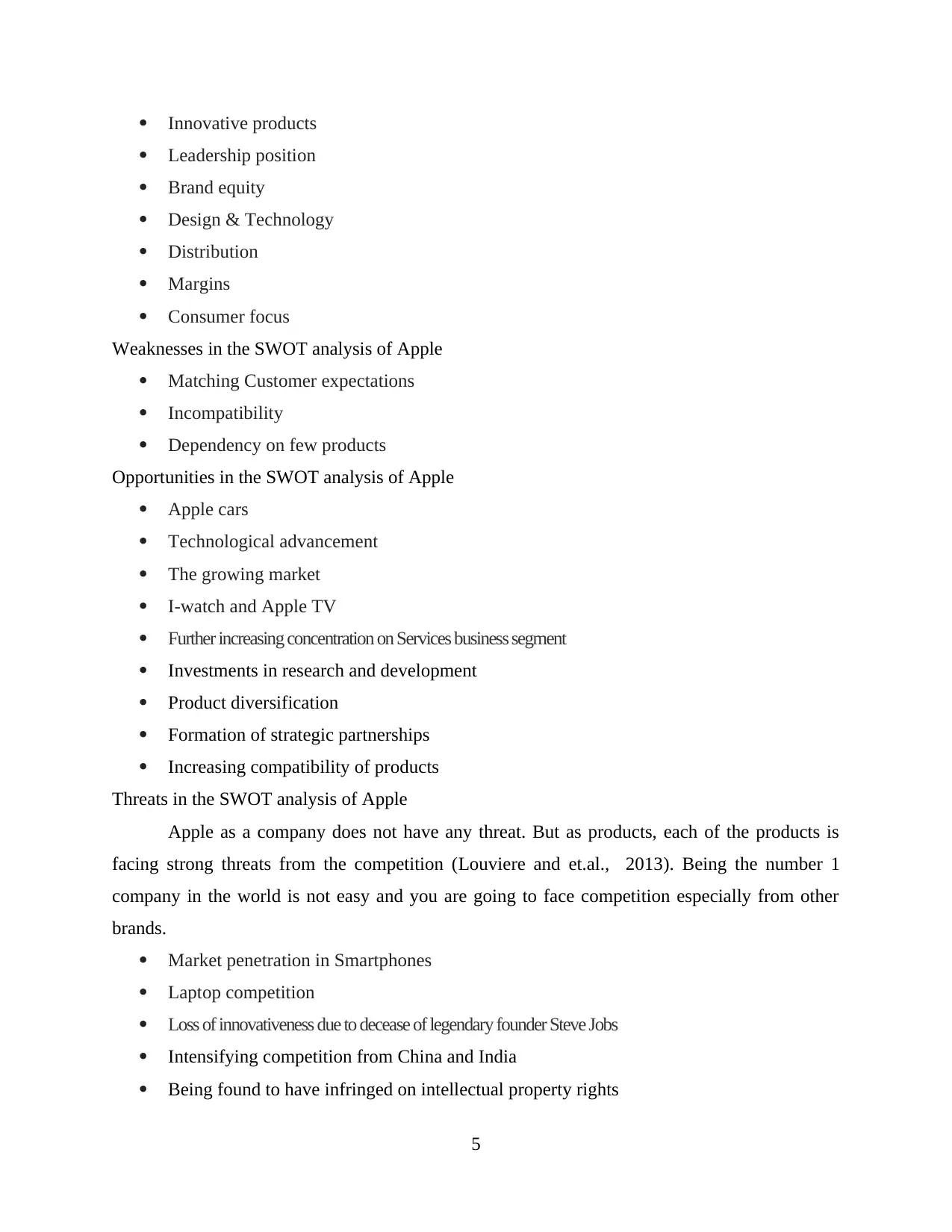
Innovative products
Leadership position
Brand equity
Design & Technology
Distribution
Margins
Consumer focus
Weaknesses in the SWOT analysis of Apple
Matching Customer expectations
Incompatibility
Dependency on few products
Opportunities in the SWOT analysis of Apple
Apple cars
Technological advancement
The growing market
I-watch and Apple TV
Further increasing concentration on Services business segment
Investments in research and development
Product diversification
Formation of strategic partnerships
Increasing compatibility of products
Threats in the SWOT analysis of Apple
Apple as a company does not have any threat. But as products, each of the products is
facing strong threats from the competition (Louviere and et.al., 2013). Being the number 1
company in the world is not easy and you are going to face competition especially from other
brands.
Market penetration in Smartphones
Laptop competition
Loss of innovativeness due to decease of legendary founder Steve Jobs
Intensifying competition from China and India
Being found to have infringed on intellectual property rights
5
Leadership position
Brand equity
Design & Technology
Distribution
Margins
Consumer focus
Weaknesses in the SWOT analysis of Apple
Matching Customer expectations
Incompatibility
Dependency on few products
Opportunities in the SWOT analysis of Apple
Apple cars
Technological advancement
The growing market
I-watch and Apple TV
Further increasing concentration on Services business segment
Investments in research and development
Product diversification
Formation of strategic partnerships
Increasing compatibility of products
Threats in the SWOT analysis of Apple
Apple as a company does not have any threat. But as products, each of the products is
facing strong threats from the competition (Louviere and et.al., 2013). Being the number 1
company in the world is not easy and you are going to face competition especially from other
brands.
Market penetration in Smartphones
Laptop competition
Loss of innovativeness due to decease of legendary founder Steve Jobs
Intensifying competition from China and India
Being found to have infringed on intellectual property rights
5
Paraphrase This Document
Need a fresh take? Get an instant paraphrase of this document with our AI Paraphraser
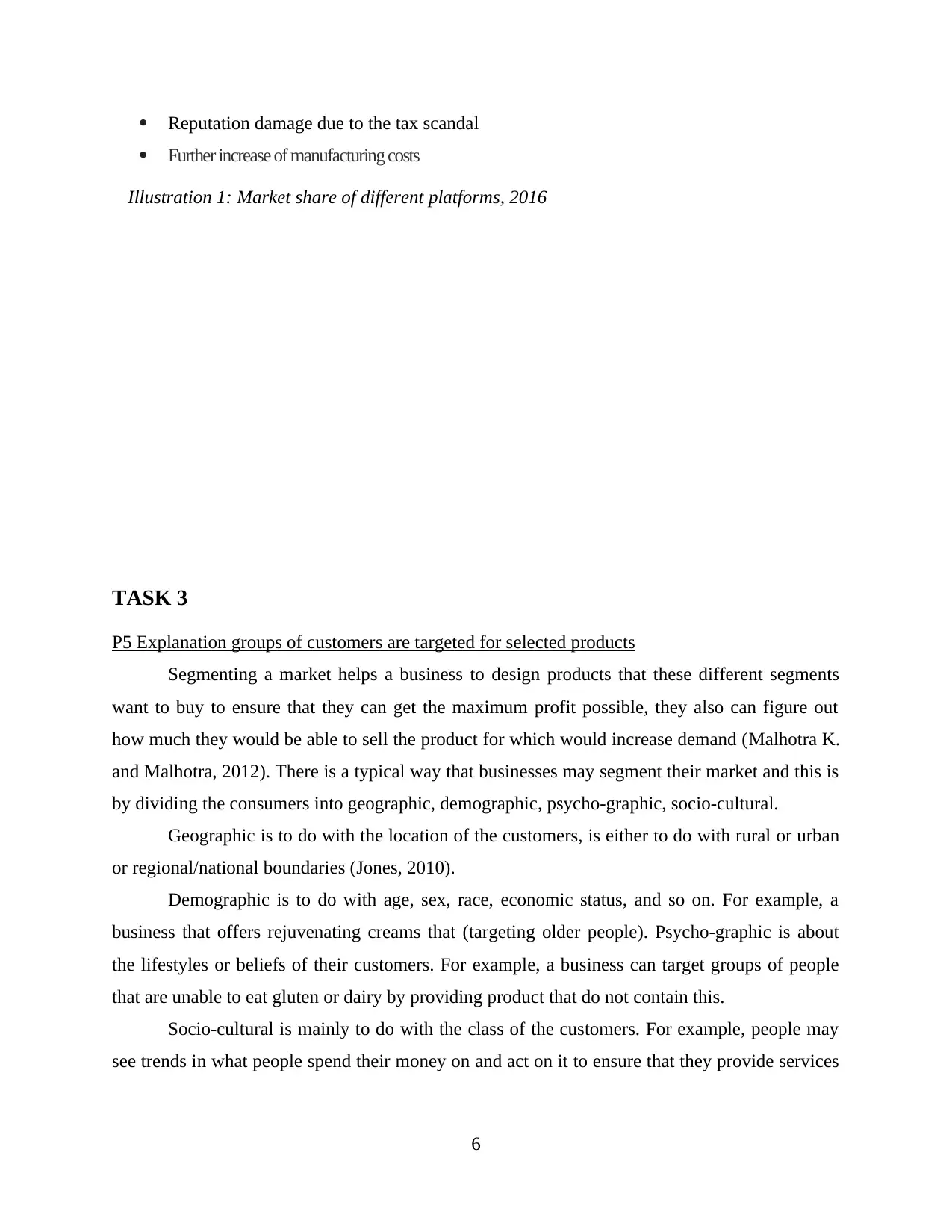
Reputation damage due to the tax scandal
Further increase of manufacturing costs
Illustration 1: Market share of different platforms, 2016
TASK 3
P5 Explanation groups of customers are targeted for selected products
Segmenting a market helps a business to design products that these different segments
want to buy to ensure that they can get the maximum profit possible, they also can figure out
how much they would be able to sell the product for which would increase demand (Malhotra K.
and Malhotra, 2012). There is a typical way that businesses may segment their market and this is
by dividing the consumers into geographic, demographic, psycho-graphic, socio-cultural.
Geographic is to do with the location of the customers, is either to do with rural or urban
or regional/national boundaries (Jones, 2010).
Demographic is to do with age, sex, race, economic status, and so on. For example, a
business that offers rejuvenating creams that (targeting older people). Psycho-graphic is about
the lifestyles or beliefs of their customers. For example, a business can target groups of people
that are unable to eat gluten or dairy by providing product that do not contain this.
Socio-cultural is mainly to do with the class of the customers. For example, people may
see trends in what people spend their money on and act on it to ensure that they provide services
6
Further increase of manufacturing costs
Illustration 1: Market share of different platforms, 2016
TASK 3
P5 Explanation groups of customers are targeted for selected products
Segmenting a market helps a business to design products that these different segments
want to buy to ensure that they can get the maximum profit possible, they also can figure out
how much they would be able to sell the product for which would increase demand (Malhotra K.
and Malhotra, 2012). There is a typical way that businesses may segment their market and this is
by dividing the consumers into geographic, demographic, psycho-graphic, socio-cultural.
Geographic is to do with the location of the customers, is either to do with rural or urban
or regional/national boundaries (Jones, 2010).
Demographic is to do with age, sex, race, economic status, and so on. For example, a
business that offers rejuvenating creams that (targeting older people). Psycho-graphic is about
the lifestyles or beliefs of their customers. For example, a business can target groups of people
that are unable to eat gluten or dairy by providing product that do not contain this.
Socio-cultural is mainly to do with the class of the customers. For example, people may
see trends in what people spend their money on and act on it to ensure that they provide services
6
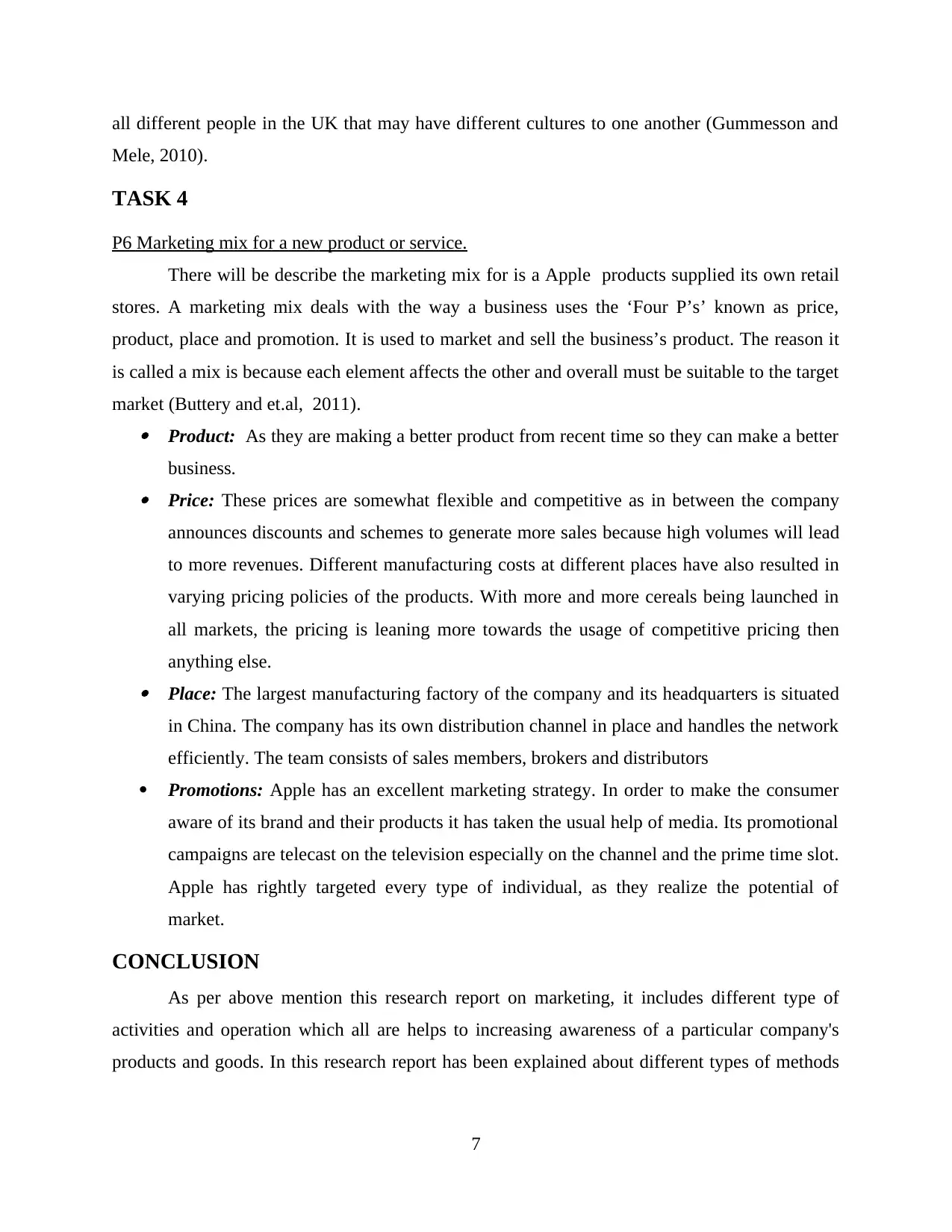
all different people in the UK that may have different cultures to one another (Gummesson and
Mele, 2010).
TASK 4
P6 Marketing mix for a new product or service.
There will be describe the marketing mix for is a Apple products supplied its own retail
stores. A marketing mix deals with the way a business uses the ‘Four P’s’ known as price,
product, place and promotion. It is used to market and sell the business’s product. The reason it
is called a mix is because each element affects the other and overall must be suitable to the target
market (Buttery and et.al, 2011). Product: As they are making a better product from recent time so they can make a better
business. Price: These prices are somewhat flexible and competitive as in between the company
announces discounts and schemes to generate more sales because high volumes will lead
to more revenues. Different manufacturing costs at different places have also resulted in
varying pricing policies of the products. With more and more cereals being launched in
all markets, the pricing is leaning more towards the usage of competitive pricing then
anything else. Place: The largest manufacturing factory of the company and its headquarters is situated
in China. The company has its own distribution channel in place and handles the network
efficiently. The team consists of sales members, brokers and distributors
Promotions: Apple has an excellent marketing strategy. In order to make the consumer
aware of its brand and their products it has taken the usual help of media. Its promotional
campaigns are telecast on the television especially on the channel and the prime time slot.
Apple has rightly targeted every type of individual, as they realize the potential of
market.
CONCLUSION
As per above mention this research report on marketing, it includes different type of
activities and operation which all are helps to increasing awareness of a particular company's
products and goods. In this research report has been explained about different types of methods
7
Mele, 2010).
TASK 4
P6 Marketing mix for a new product or service.
There will be describe the marketing mix for is a Apple products supplied its own retail
stores. A marketing mix deals with the way a business uses the ‘Four P’s’ known as price,
product, place and promotion. It is used to market and sell the business’s product. The reason it
is called a mix is because each element affects the other and overall must be suitable to the target
market (Buttery and et.al, 2011). Product: As they are making a better product from recent time so they can make a better
business. Price: These prices are somewhat flexible and competitive as in between the company
announces discounts and schemes to generate more sales because high volumes will lead
to more revenues. Different manufacturing costs at different places have also resulted in
varying pricing policies of the products. With more and more cereals being launched in
all markets, the pricing is leaning more towards the usage of competitive pricing then
anything else. Place: The largest manufacturing factory of the company and its headquarters is situated
in China. The company has its own distribution channel in place and handles the network
efficiently. The team consists of sales members, brokers and distributors
Promotions: Apple has an excellent marketing strategy. In order to make the consumer
aware of its brand and their products it has taken the usual help of media. Its promotional
campaigns are telecast on the television especially on the channel and the prime time slot.
Apple has rightly targeted every type of individual, as they realize the potential of
market.
CONCLUSION
As per above mention this research report on marketing, it includes different type of
activities and operation which all are helps to increasing awareness of a particular company's
products and goods. In this research report has been explained about different types of methods
7
⊘ This is a preview!⊘
Do you want full access?
Subscribe today to unlock all pages.

Trusted by 1+ million students worldwide
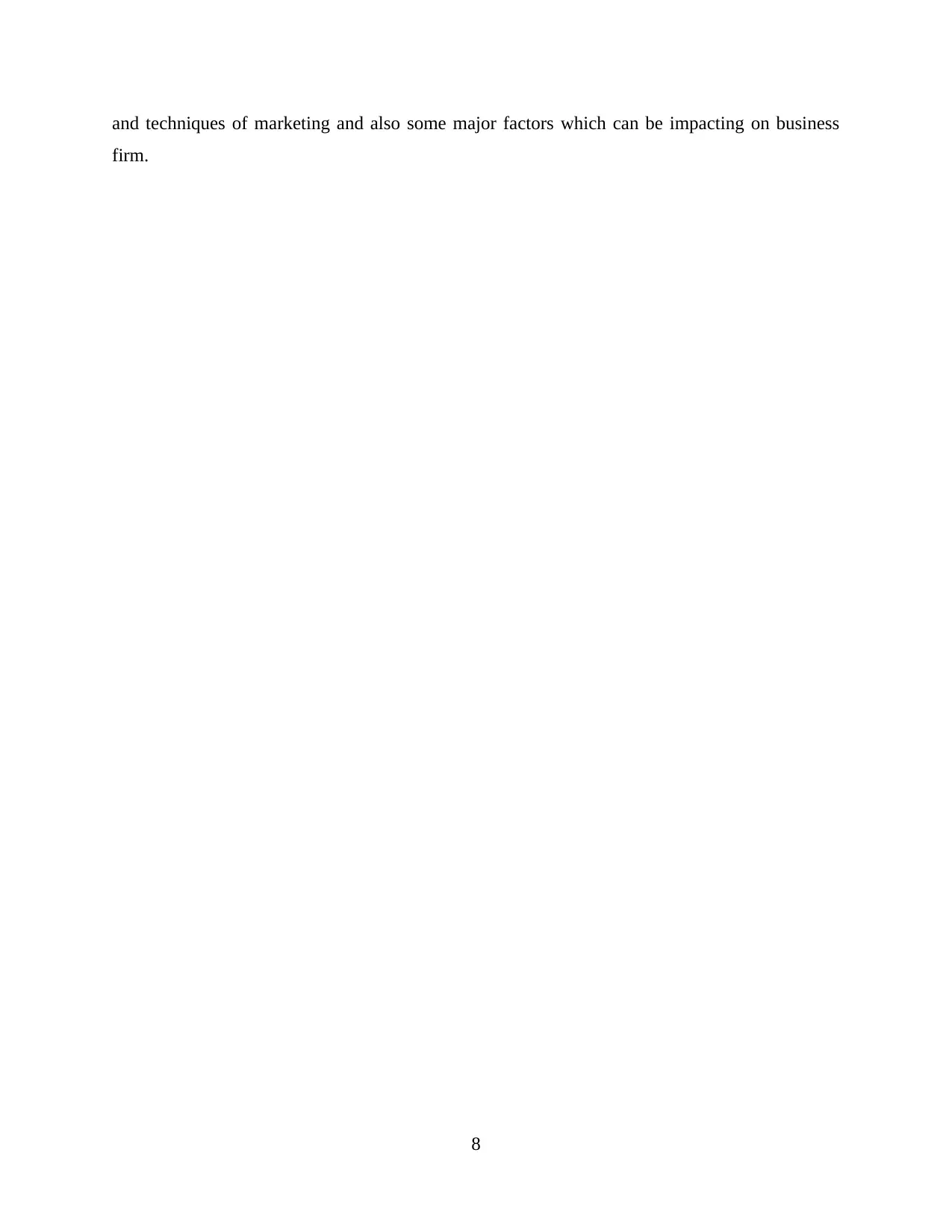
and techniques of marketing and also some major factors which can be impacting on business
firm.
8
firm.
8
Paraphrase This Document
Need a fresh take? Get an instant paraphrase of this document with our AI Paraphraser
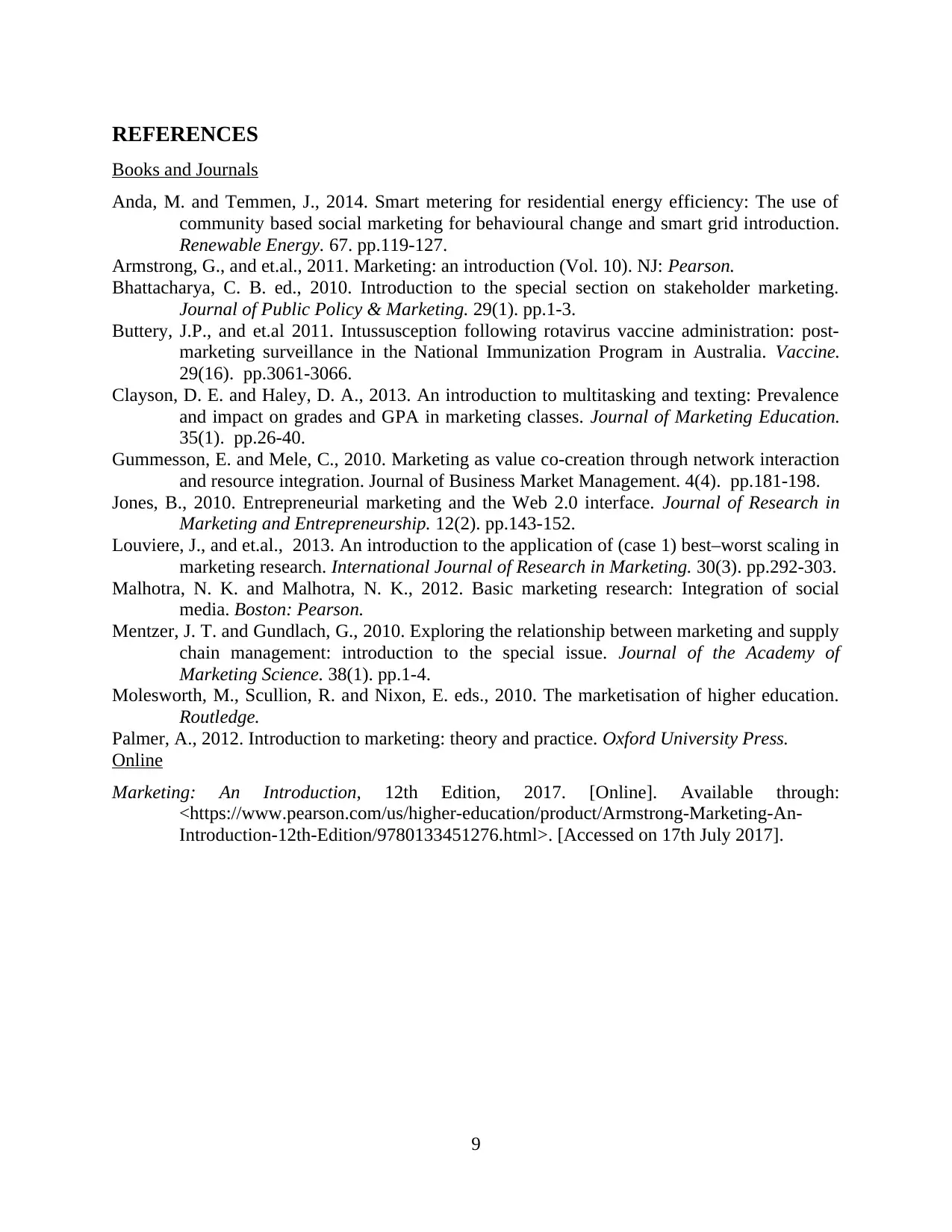
REFERENCES
Books and Journals
Anda, M. and Temmen, J., 2014. Smart metering for residential energy efficiency: The use of
community based social marketing for behavioural change and smart grid introduction.
Renewable Energy. 67. pp.119-127.
Armstrong, G., and et.al., 2011. Marketing: an introduction (Vol. 10). NJ: Pearson.
Bhattacharya, C. B. ed., 2010. Introduction to the special section on stakeholder marketing.
Journal of Public Policy & Marketing. 29(1). pp.1-3.
Buttery, J.P., and et.al 2011. Intussusception following rotavirus vaccine administration: post-
marketing surveillance in the National Immunization Program in Australia. Vaccine.
29(16). pp.3061-3066.
Clayson, D. E. and Haley, D. A., 2013. An introduction to multitasking and texting: Prevalence
and impact on grades and GPA in marketing classes. Journal of Marketing Education.
35(1). pp.26-40.
Gummesson, E. and Mele, C., 2010. Marketing as value co-creation through network interaction
and resource integration. Journal of Business Market Management. 4(4). pp.181-198.
Jones, B., 2010. Entrepreneurial marketing and the Web 2.0 interface. Journal of Research in
Marketing and Entrepreneurship. 12(2). pp.143-152.
Louviere, J., and et.al., 2013. An introduction to the application of (case 1) best–worst scaling in
marketing research. International Journal of Research in Marketing. 30(3). pp.292-303.
Malhotra, N. K. and Malhotra, N. K., 2012. Basic marketing research: Integration of social
media. Boston: Pearson.
Mentzer, J. T. and Gundlach, G., 2010. Exploring the relationship between marketing and supply
chain management: introduction to the special issue. Journal of the Academy of
Marketing Science. 38(1). pp.1-4.
Molesworth, M., Scullion, R. and Nixon, E. eds., 2010. The marketisation of higher education.
Routledge.
Palmer, A., 2012. Introduction to marketing: theory and practice. Oxford University Press.
Online
Marketing: An Introduction, 12th Edition, 2017. [Online]. Available through:
<https://www.pearson.com/us/higher-education/product/Armstrong-Marketing-An-
Introduction-12th-Edition/9780133451276.html>. [Accessed on 17th July 2017].
9
Books and Journals
Anda, M. and Temmen, J., 2014. Smart metering for residential energy efficiency: The use of
community based social marketing for behavioural change and smart grid introduction.
Renewable Energy. 67. pp.119-127.
Armstrong, G., and et.al., 2011. Marketing: an introduction (Vol. 10). NJ: Pearson.
Bhattacharya, C. B. ed., 2010. Introduction to the special section on stakeholder marketing.
Journal of Public Policy & Marketing. 29(1). pp.1-3.
Buttery, J.P., and et.al 2011. Intussusception following rotavirus vaccine administration: post-
marketing surveillance in the National Immunization Program in Australia. Vaccine.
29(16). pp.3061-3066.
Clayson, D. E. and Haley, D. A., 2013. An introduction to multitasking and texting: Prevalence
and impact on grades and GPA in marketing classes. Journal of Marketing Education.
35(1). pp.26-40.
Gummesson, E. and Mele, C., 2010. Marketing as value co-creation through network interaction
and resource integration. Journal of Business Market Management. 4(4). pp.181-198.
Jones, B., 2010. Entrepreneurial marketing and the Web 2.0 interface. Journal of Research in
Marketing and Entrepreneurship. 12(2). pp.143-152.
Louviere, J., and et.al., 2013. An introduction to the application of (case 1) best–worst scaling in
marketing research. International Journal of Research in Marketing. 30(3). pp.292-303.
Malhotra, N. K. and Malhotra, N. K., 2012. Basic marketing research: Integration of social
media. Boston: Pearson.
Mentzer, J. T. and Gundlach, G., 2010. Exploring the relationship between marketing and supply
chain management: introduction to the special issue. Journal of the Academy of
Marketing Science. 38(1). pp.1-4.
Molesworth, M., Scullion, R. and Nixon, E. eds., 2010. The marketisation of higher education.
Routledge.
Palmer, A., 2012. Introduction to marketing: theory and practice. Oxford University Press.
Online
Marketing: An Introduction, 12th Edition, 2017. [Online]. Available through:
<https://www.pearson.com/us/higher-education/product/Armstrong-Marketing-An-
Introduction-12th-Edition/9780133451276.html>. [Accessed on 17th July 2017].
9
1 out of 11
Related Documents
Your All-in-One AI-Powered Toolkit for Academic Success.
+13062052269
info@desklib.com
Available 24*7 on WhatsApp / Email
![[object Object]](/_next/static/media/star-bottom.7253800d.svg)
Unlock your academic potential
Copyright © 2020–2025 A2Z Services. All Rights Reserved. Developed and managed by ZUCOL.




